
Asmaa Abdul-Amin
Just here learning 📚
My Projects
Repositories that I've built.
A machine learning (ML) algorithm to annotate diverse protein complexes (biological particles with well-defined structures) in 3D cellular images, accelerating discoveries in biomedical science and advancing disease treatment.
This project contains code for The Johns Hopkins University Applied Physics Laboratory 2023 BYTES Challenge, examining the effect of U.S. states' COVID-19 policy enactment dates on overall death totals.
Define candidates for optimal portfolio using comparison between expected returns and the risk from each stock in the SP500. Then calculate and save the Find the Minimum Variance Portfolio (MVP) optimal weights to CSV files.
Create a utility class that manipulates a two-dimensional ragged array of doubles.
In this lab, you will be creating new classes that are derived from a class called BankAccount. A checking account is a bank account and a savings account is a bank account as well.
An application that lets the user create a management company and add the properties managed by the company to its list.
In this Lab, you will work with a 4-row, 20-column, two-dimensional array of integers. You will write methods that perform operations on the array.
A driver class to test the various methods provided in the data element class.
this code generates 'buy' and 'sell' signals based on a moving average crossover strategy
A tic tac toe game implementation using the Minimax algorithm to determine optimal moves.
This is a sudoku solver using the backtracking algorithm. It includes a graphical GUI as well as a text based version.
A recipe list app that displays popular recipes.
An iOS slot machine Game
My Interests
Topics that I want to learn more about.





